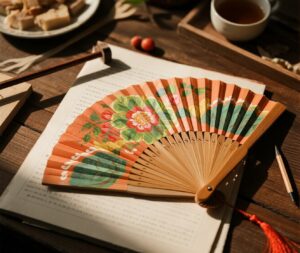目录
ToggleA painted wooden hand fan, spread out on a desk, reveals not only the pattern on the fan’s surface but also the grain of the wood, the layers of paint, and the patience that goes into every step of the production process.

From a tree growing in the mountains to an object held in the hand, a painted wooden hand fan undergoes dozens of polishing processes.
1. Selection and treatment of wood for painted wooden hand fans
- The wood used for hand fans is often hardwood, characterized by a long growth cycle, high density, fine grain, and resistance to deformation.
- After felling, the wood is naturally dried and stored in a well-ventilated shed, protected from direct sunlight and rain. This process is to reduce the moisture in the wood and make it drier.The dried wood is then cut into strips of uniform thickness, which are then planed to create the initial shape of the fan ribs.
- Integrate the selected wood until it is smooth.The sanding should be done in the direction of the wood’s grain, as this will easily cause scratches.
- The sanded ribs are then immersed in a beeswax solution and left to stand for half an hour before removal. The beeswax forms a protective film that is both waterproof and enhances the wood’s grain.
2. Splicing and shaping the ribs of a painted wooden hand fan
- The length and width of the ribs of a hand fan must be precisely aligned to ensure smooth opening and closing. The connection of the fan ribs depends entirely on the fit between the wood and the wood.
- At the base of the ribs, the craftsman chisels tiny grooves, inserting a highly resilient bamboo strip through the grooves, leveraging the strip’s elasticity to secure the ribs.
- To make the handle of a painted wooden fan, a larger piece of wood is selected and then tooled into the desired shape. A hole is then drilled at the end for the hanging cord. The connection between the handle and the ribs is angled to ensure a natural arc when the fan is unfolded.
- After all the ribs are joined, the craftsman conducts a test opening and closing to detect any stagnation. If there is excessive resistance at any fan connection, gently grind the connection with a tool until all the fan brackets open and close synchronously.This process often requires repeated iterations to achieve the desired effect.
3. Stretching and processing of painted wooden hand fans
- The surface of a painted wooden hand fan is often made of rice paper or fine cotton cloth. Before the hand fan is completed, the hand fan bracket must be fixed on a special bracket for placing the hand fan so that it can be fully unfolded.The cut paper or cloth is laid flat on the ribs and glue is applied along the edges.
- Use a special tool to gently smooth the paper or cloth, making sure the fan frame fits snugly against the surface. When the glue is partially dry, use scissors to trim the surface along the ribs, leaving a 1mm margin around the edges to prevent shrinkage and cracking. Finally, place the stretched hand fan in a cool, dark place to air for two days, away from water and wind.
- After drying, the fan surface is treated with alum. Apply it evenly to the fan surface with a soft-bristled brush. This creates a stiffer surface and prevents paint from smearing during subsequent painting.
- After the alum treatment, the fan surface should be allowed to dry again. The surface will now have a light off-white hue and a tough, resistant texture.
4. The process and pigments of painted wooden hand fans
- The first step in painting is the rough draft. The artist will use a very fine charcoal pencil to outline the design on the fan, using light strokes to facilitate modification. After the rough draft is complete, the outline is fixed with light ink to prevent the charcoal lines from blurring during subsequent coloring.
- Traditional painting uses mineral and plant pigments. A small amount of glue is added during the mixing process to ensure the pigment adheres to the fan and maintain the color’s vividness.
- When painting a painted wooden hand fan, the principle of “starting from light to dark” is followed. After each color is applied, it must be completely dry before moving on to the next step to prevent blending.
5. The Function and Heritage of Painted Wooden Hand Fans
- The practical function of a painted wooden hand fanis, first and foremost, to provide cooling air. Furthermore, some exquisitely crafted fans are often given as gifts on important occasions.
- If apainted wooden hand fan becomes stained during use, simply wipe it with a soft cloth dampened with a small amount of clean water; avoid using chemical cleaners. When not in use for extended periods, store it in a dry box to avoid moisture.









